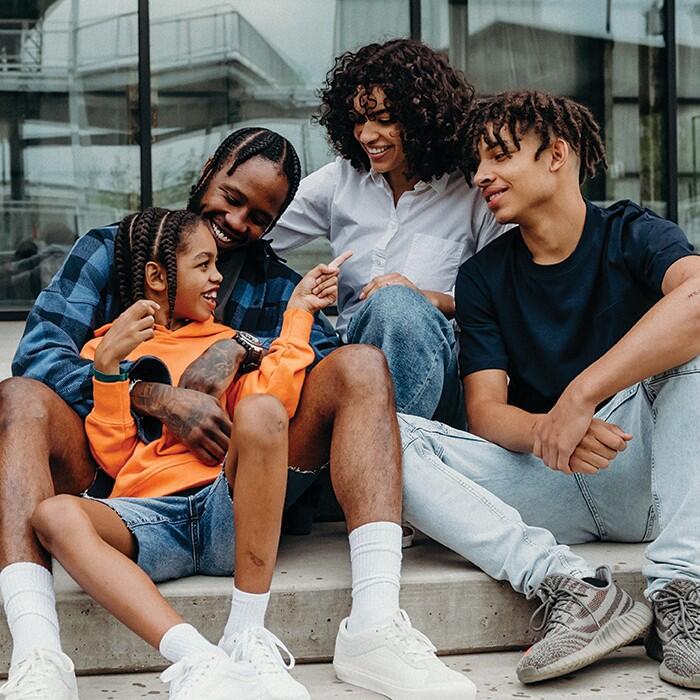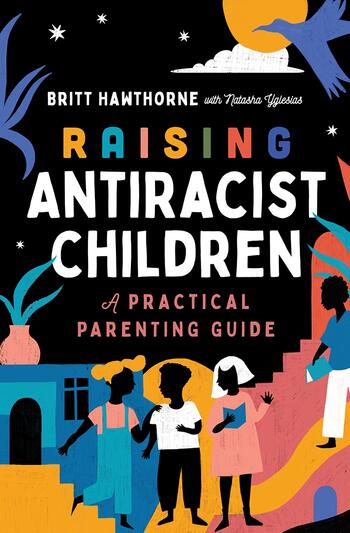Safe and equitable spaces for all young people require dynamic social justice learning. And parents and caregivers are at the forefront in efforts to give children the foundation to build future inclusive societies.
Britt Hawthorne, nationally recognized anti-racist educator and author of Raising Antiracist Children: A Practical Parenting Guide, expressed the sentiment in her note to parents that, “It is never too early to start creating a home rooted in justice, compassion, and love.” We agree—it is never too early for children to learn to build a society with those values. Nor is it ever too late for adults to honestly confront our country’s history and our own biases to shape a more just future.
Hawthorne, who provides anti-racism and anti-bias trainings for parents and educators, took time for a conversation with Learning for Justice, sharing her insights as a parent and educator.

Raising Antiracist Children serves as a valuable practical guide for parents, caregivers and educators, many of whom feel overwhelmed and are unsure where to start. Please tell us about the practice of anti-racism in our daily lives.
Every child deserves the right to be parented in an anti-racist way. It’s never too late or too early to start practicing anti-racism. What’s important is that you’re practicing it now. Caregivers practice anti-racism because we wish for our children to reach their fullest potential and become more compassionate, empathetic human beings. Before starting new activities or purchasing new books, we want to cultivate community. The foundation of our liberation framework will always be community.
We must develop the ability and capacity to care for one another deeply. When we’re genuinely in and relating to our community, we’ll sense the injustices and justices of the world. We will notice who is constantly erased in discussions and the communities most impacted by political decisions. If we’re lucky enough to have a strong community, its members will challenge us to take action, encourage us to listen more and share our wisdom. We will truly learn how to hold ourselves accountable.
As anti-racists, we advocate for the justice of other identity groups because liberation should not be exclusionary or conditional. We must remember that Black and Brown folks can be queer, trans, disabled, Muslim, Jewish, neurodivergent and any number of other identities; there is no finite list. Focus on having honest representation in the toys, books and movies in which your children engage. Share what TV shows you’re watching that promote inclusivity and justice. Share books and toys to encourage collectivist thinking. When white folks are overrepresented in books or movies, identify it as racism: “Huh, everyone in this book has pale skin. That’s not what the world is really like. This book is upholding racism, so let’s put it back.”
But don’t just stop there; include anti-racism in everything you do, including playtime. When I’m building with my child, I ask him questions that will make him think about his neighbors. For instance, if he wants to build a house, school or castle, I can ask him: “Oh wait, where’s our ramp for people who use wheelchairs and have strollers?” “What’s this? Wow, a basketball court in the house. How about a swimming pool? We can add a kiddie pool for the younger children. Where are the grandparents going to play?”
Anti-racism also calls us to center Black people and people of the global majority in our home. Children of the global majority need to know they come from a place of power before they learn about the oppression their community experiences. Amelia Allen Sherwood’s practice, “Taking Up Space,” in Raising Antiracist Children: A Practical Parenting Guide reminds us all to make space for Black and Indigenous children to take up.
You explained that you chose specific anti-racist values that “directly disrupt harmful dominant beliefs, support critical thinking, and allow our children to live out values of justice.” Will you elaborate on your chosen anti-racist values?
Two of my values are love and justice. What drove me to develop them was the slow and deeply vulnerable process of unpacking and analyzing how the white supremacy characteristics—identified by Tema Okun—unintentionally showed up in my parenting practice. Once I unpacked these characteristics, I was called to choose the values that I would use to lead me. My values resist my natural tendency to avoid conflict and my desire to be the perfect parent with the correct answers who has it all figured out. Instead, I seek authenticity, curiosity, collaboration, accountability, becoming, empowerment and candor. These values are further broken down in my book with examples for each.
Accomplices and co-conspirators are all about change. They’re willing to change policies, their minds and their lifestyles for the betterment of all children. When necessary, they’re ready to take risks and challenge people.
You use the terms co-conspirator and accomplice and differentiate them from the word ally. Will you define these for us? And what would you say to people who express concerns about using the terms co-conspirator and accomplice?
Active allies are learning how racism affects the lived experiences of people of the global majority. It’s an important place to start, yet it’s not to be confused with anti-racism. Remember, anti-racism is the active resistance to racism. Building awareness is crucial but does little to change the current levels of discrimination and oppression that people of the global majority experience.
Accomplices and co-conspirators are aggressively seeking to address how racism is systemic. They understand the power imbalance that has been part of many foundational institutions, including the classroom, throughout history. They already understand that racism can manifest in individual attitudes and behaviors and in formal policies and practices like grading policies, classroom management philosophies and classroom celebrations. The big difference between allies and the latter group is action. Accomplices and co-conspirators are all about change. They’re willing to change policies, their minds and their lifestyles for the betterment of all children. When necessary, they’re ready to take risks and challenge people.
One of my favorite things about using these terms is the awareness and accuracy one must have to understand them. I remember when I first started consulting about anti-racism, potential clients would request that I use another, gentler word instead of anti-racism. I chose not to substitute another word for anti-racism because there isn’t any other word that would carry the same clarity and weight. The same goes for accomplices and co-conspirators. When truly practicing anti-racism, accomplices and co-conspirators understand they’ll have to risk something in the name of justice.
What can parents, caregivers and educators do to help ensure schools are centering justice, equity and affirming spaces for children of all races and identities?
Expect and accept advocacy in your space. It’s time we start moving to action, changing the culture of our classrooms and homes by what we expect and accept from our learners. Gone are the days when classrooms and homes were places of compliance. Now more than ever, we must explicitly teach our learners to advocate for themselves and their peers. I’ve found success in breaking the idea of action into two different categories: advocacy and activism.
Advocacy happens on an individual level and is usually between two people. Activism occurs on an institutional level and can involve several people. Speaking up, leaving an unsafe situation and reporting are all examples of individual advocacy. Joining a protest, boycotting and creating a new organization are examples of activism. Of course, as grownups, we use these terms interchangeably, and that’s welcomed. I choose to take my time and break these concepts into smaller, more manageable ideas for learners.
Role-playing advocacy phrases for common incidents are essential for our youngest learners. It shows them that we expect them to advocate for themselves. But role-playing isn’t enough; you must create a culture of accountability and advocacy. As adults, it’s imperative that we also model advocacy. Just the other day, we were flying back from Chicago to Houston. While waiting to board, another person attempted to cut in line. Younger me would have let it go and explained it away by saying, “We’re all going to the same place.” Truthfully, I wouldn’t have spoken up because I wasn’t confident enough. I’ve committed to speaking up more and taking up more space. At that moment, I firmly said, “I’m next.” Once we found our seats, our 9-year-old told me he was proud of how I spoke up for us. I still have a long way to go, and my children are rooting for me along the way.
I want my children to know that advocacy is the pathway to activism and accountability. Activism offers radical imagination and action to our community. It’s about sharing our most profound hopes, and it challenges us to take full responsibility in a situation. When we genuinely practice activism, we are charged to be our most liberated selves by aligning our values and actions.
Your book contains some lovely affirming activities. Would you share a favorite one for families and caregivers?
There’s a reason why we regularly witness toddlers and preschoolers dancing, singing and moving their bodies. Music is powerful! Music affects our mood and our attitude. Dancing, singing and movement activities are liberating to our bodies and must become practices we embrace. In our home, we use music to affirm us, build our confidence and make memories. One of my favorite affirming activities is “Make a Playlist!” You’ll find my top 10 song choices in my book to build confidence and self-love.
And would you share one that might be helpful for a teacher in building an affirming classroom community?
When I consult with schools, I encourage classroom teachers to spend the first six to nine weeks intentionally building community with their learners. We want our learners to have a strong sense of interdependence among themselves and to feel safe with their teachers. This is especially true for classroom communities diving into conversations about racism, homophobia or classism. One of our family favorite activities was “Two Truths and a Wish.” It’s a play on “Two Truths and a Lie.” It is an awesome community-building game but doesn’t ask learners to lie to have fun. Allow learners five minutes to think of two things that are true about them and one thing they wish to be true. Break them into pairs or small groups to see who knows them best. This activity can be repeated throughout the school year.

Raising Antiracist Children: A Practical Parenting Guide
by Britt Hawthorne with Natasha Yglesias
Publisher: S&S/Simon Element
Length: 320 pages
ISBN13: 9781982185428
